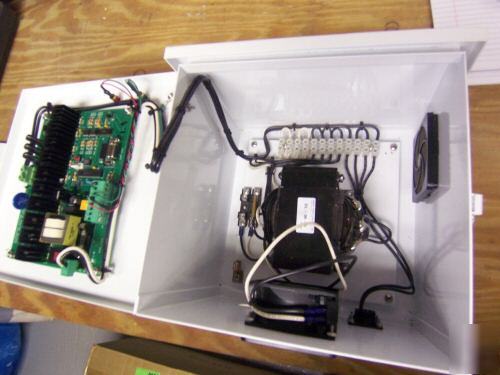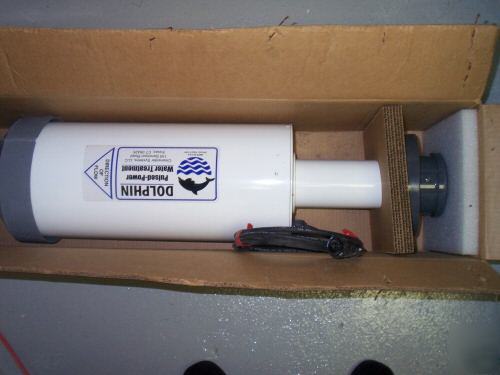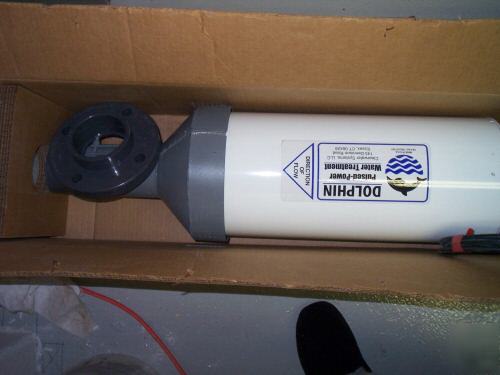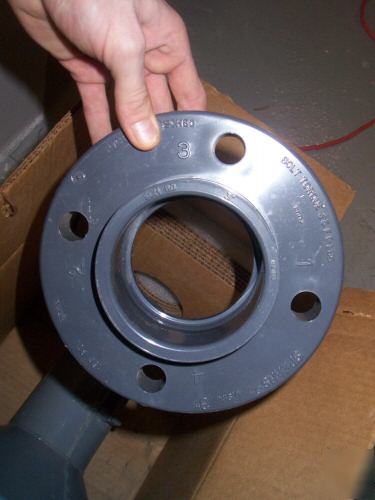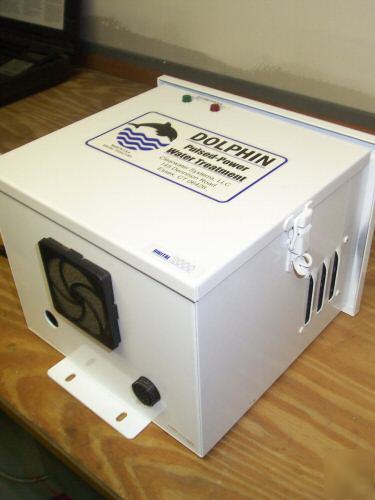Quiet Electronics Moderated Newsgroup For The Electronic Professionals and Other Professionals > Indiana
> Wholesale
> Dolphin pulsed-powered H2O treatment pump cooling tower
Dolphin pulsed-powered H2O treatment pump cooling tower
Be sure to add me to your favorites list!
FOR MORE INFO, GO TO: http:// /index.htm
I beleive this item is BRAND NEW and has never been installed. It shows no signs of wear or of installation. (99% sure)
* Operating Principle. The Dolphin produces a pulsed, time-varying, induced field inside a PVC pipe that is fit conveniently into the cooling tower's recirculating water system. The electric signal changes the way minerals in the water precipitate, totally avoiding hard-lime scale by instead producing a non-sticking mineral powder in the bulk water. This powder is readily filterable and mostly removed during normal blowdown, or it settles loosely in the cooling tower basin for easy annual removal. Bacteria are incorporated into this mineral powder and therefore leave the system by blowdown, filtration, or settling. The encapsulated bacteria cannot reproduce, thus resulting in an exceedingly low bacteria population. Water softening is not necessary with Dolphin treatment, and high cycles of concentration are usually obtainable, leading to significant water conservation.
The Transformer Panel can be easily mounted on any flat surface using the built-in external flanges and four mounting screws.
The Coil-Pipe Assembly simply replaces an existing pipe section to complete the non-restricting, flow-through installation.
Uses standard 110V or 220V electric service, depending on Dolphin model size.
* Specific Enhancements to Cooling Tower Systems
Avoids premature system leaks by preventing microbial-induced corrosion (MIC) caused by bio-debris.
Extends the operational life of cooling tower systems by maintaining an alkaline pH without chemical additives.
* Effortless Operational Use
No moving parts. No consumable supplies.
Automatically eliminates scale and bio-debris buildup from clogging valves and heat exchanger channels.
Tolerates operational variables without requiring adjustments.
* Customized Engineered Solutions
Want to avoid chiller fouling?
Concerned with minimizing Legionella risk?
Is energy efficiency a high priority? If so…
Click on image for larger view
The Dolphin Pulsed-Powered Water Treatment of Cooling Towers
* Total bacteria counts are way below any other water-treatment method (1000-2000 CFU/ml).
* No odor and a water clarity superior to tap water.
* Virtually no algae, fungus, or higher life forms on wetted surfaces.
* Excellent corrosion protection using natural conditions without corrosive chemicals.
* No encrustation of the fill, bio-debris, or fouling of the chiller.
* End regulatory, liability, and health-and-safety concerns with chemicals.
* Improve and simplify mechanical room housekeeping.
* Eliminate the environmental impact of blowdown, air emissions, and drift from toxic chemicals.
* Eliminate biofilm as a breeding ground for microbial life and Legionella amplification.
* Eliminate all chemical costs.
* Elimination of scale and biofilm throughout the system results in greater heat transfer and lower energy costs.
* Significant savings of water (purchase and disposal fees).
* Reduced maintenance of the tower and chiller
The operating principles of the Dolphin Series are based on four essential methods of action: electromagnetic signal; interaction of the induced electric field with colloidal particles; control of microbial populations; and corrosion control. These methods of action as discussed as follows.
Dolphin devices impart pulsed, high frequency electromagnetic energy into flowing water by inducing varying electromagnetic fields 60 times per second. During each cycle, the field strength varies from 0 to a maximum value then back to 0. Half way through each cycle the field is pulsed, causing a ringing effect. This ringing has a natural frequency based on the geometry of the coil and the capacitance of the circuitry. Over a time period of about 3 milliseconds, this field decays to a few percent of its original intensity. The transient decay causes harmonics of the natural frequency, resulting in measurable frequencies up to the megahertz range. This time-varying magnetic field induces a rapidly changing electric field in the water system of the same frequency as the magnetic field but in a direction around the circumference of the pipe.
B. Interaction of the Induced Electric Field with Colloidal Particles
The Dolphin's pulsed-power system (PPS) works by changing how calcium carbonate and other dissolved minerals precipitate from solution. Pulsed-power fields activate colloidal nucleation sites in the bulk solution. These activated sites become the preferential nucleation sites for precipitation.
Click to Enlarge Calcium carbonate is the mineral commonly present in water with the lowest solubility, i.e., it is the first precipitate to form in a cooling tower. Precipitation of calcium carbonate and other dissolved minerals occurs when the minerals in solution reach supersaturation levels. Supersaturation is primarily reached by the evaporation of water. The evaporated water contains no minerals, and the decreased volume of fluid increases the concentration of minerals.
The precipitation of calcium carbonate can occur as either a surface-nucleating scale or a colloidal-nucleating powder in the bulk solution. Growth on existing solids is thermodynamically favored. The unique spectrum of electromagnetic fields produced by pulsed power shifts the CaCO3 equilibrium chemistry to favor formation of stable crystal nuclei in the bulk solution. Thus crystal growth and precipitation will occur in solution and accumulate as a loose powder instead of on a surface as a scale.
Photomicrographs of the two minerals are shown on the following magnifications:
Bulk-Solution Precipitate 60x
The morphology of these two photos displays the typical layered structure of adherent, surface-nucleating scale, and the amorphous, almost spherical, appearance of the pulsed-power induced, bulk-solution precipitate. These samples were collected from cooling towers receiving chemical or pulsed-power treatment, respectively.
The amorphous precipitate does not adhere to the pipe wall but remains with the bulk solution and is removed via blowdown and/or side-stream filtration. The Dolphin uses colloidal science instead of inorganic chemistry to control scaling.
C. Control of Microbial Populations
The Dolphin System™ is a bacteriostatic product rather than a true bactericide. Although the bacteria are not killed, they are controlled. A chemically controlled tower trying to balance the cost of biocide chemicals and the cost of corrosion inhibitors that are needed to protect the tower from the biocides will usually aim for a Total Bacteria Count as measured in a standard 48-hour, 35º C heterotrophic plate count (method SMEWW 9215) of about 20,000 to 50,000 CFU/ml. In addition, many of the bactericides are species-specific, and they must be periodically changed to prevent a different species from flourishing. Mutation of species such that previously effective biocides become ineffective on the mutated species is a problem for chemically controlled towers.
With a Dolphin , although the bacteria are not immediately killed, they are controlled. Total Bacteria Count using the standard 48-hour test will typically show 1,000 to 2,000 CFU/ml in a cooling tower being operated under a normal blowdown regime. The following figure shows typical results achieved with pulsed-power. Tower #1 and Tower #2 are located at a manufacturing facility in Connecticut. They are 175-ton towers being run at 8 cycles of concentration. As shown below, each tower is plotted as a separate line. Tower #1 had been under PPS control for nearly one year before the data were taken. The results show levels ranging between 102 and 104 counts, with 103 being a typical value. There is no discernible pattern in the values.
Tower #2 presents the bacterial counts while under chemical treatment (until 3/22/00) and then during PPS treatment. The bacterial concentrations under chemical control are high and erratic, ranging from 103 to 106 CFU/ml, with 105 being a typical value. The large drops in counts correspond to high levels of free chlorine in the system. The quick recovery of the biological counts is indicative of a viable biofilm in the system and a variable odor was present.
PPS installed on Tower #2 on 3/22/00
There are two separate mechanisms that cause these low levels of biological activity. The first relates to the well-established effect in water treatment that coagulation and calcium carbonate precipitation will result in a microbial reduction. Operating a tower with coagulation and precipitation occurring in the bulk solution, as it happens in water treatment plants, will incorporate microbes in the water into the growing crystal precipitates. This effect is not as pronounced in scale formation, since only the bacteria close to surfaces can be incorporated into the precipitate. The encased bacteria can be revived, but they are physically constrained in the precipitate and unable to reproduce. With microorganisms controlled by physical incorporation, changes in the make-up of the microbe population over time will have no effect on the efficacy of the system. Mutation or resistant strains of bacteria do not flourish in a pulsed-power controlled tower.
The second mechanism involves sub-lethal injury that controls bacteria even when there is no precipitation occurring. This mechanism is based on the interaction of the low frequency radiation generated by the pulsing with the bacteria.
Maxwell Laboratories in California was first organization to commercially develop pulsed-power. Pulsed-power is the basis of cold pasteurization, an FDA- approved technique to pasteurize fluids such as fruit juices. The original Maxwell patent details a process in which microbes are exposed to pulsed magnetic fields of equivalent frequencies, duration and decay rate as those in a cooling tower but at 100 times higher fluxes. At this flux and frequency, a single pulse in a low-conductivity fluid, such as cooling-tower recirculating water, will reduce the population of microorganisms by two or more orders of magnitude.
Pulsing a magnetic field in this way generates very low frequency, non-ionizing electromagnetic radiation. This radiation has a much lower frequency than microwave radiation, even lower than radio waves, but has a demonstrable effect on microorganisms. Frequency is a measure of how much energy each individual photon of the radiation contains. The square of the flux is a measure of the quantity of photons. Both the frequency and the flux are related to the total energy input from the device.
Since the frequency of the Dolphin cooling-tower products are the same as the Maxwell products, the energy of each individual photon is the same with both devices. The flux with the Maxwell device is 100 times higher than the flux with Dolphin devices; therefore, the number of photons per pulse is 10,000 times higher. A cooling-tower Dolphin device thus uses a fraction of the energy that the Maxwell devices use on a per pulse basis. However, because cooling towers involve recirculating water, a Dolphin device on a cooling tower will "see" each bacterium many times before the bacterium exits the system. Click to Enlarge In a typical cooling tower setup, each bacterium will see over 5000 pulses, exposing the bacteria to over 50% of the total amount of radiation as with the Maxwell device.
Spreading this exposure over a few hours does not have the same biological effect as a single dose; however, there is damage to the microorganisms. This damage is sufficient to inhibit reproduction but not sterilize the system. The bacteria can recover in a few days, but while they are recirculating through the Dolphins they are inactive.
Corrosion inhibition with the Dolphin System â„¢ is accomplished indirectly by maintaining sufficient cycles of concentration to force the system into the alkaline mode at the saturation point of calcium carbonate, which is a cathodic corrosion inhibitor. In this type of water system, the expected corrosion rate on mild steel is 2 to 5 mils per year. The Cooling Technology Institute Guideline WTP-130 lists corrosion rates in cooling towers on mild steel of 2 to 5 mpy as "good" and 0 to 2 mpy as "excellent". In many municipal water systems phosphates or silicates are as corrosion inhibitors to meet EPA's copper/lead requirements. In these systems when cycled up, the corrosion rate on mild steel is typically less than 2.0 mpy.
Pulsed power technology offers significant advantage in corrosion control over chemical treatment with respect to copper. While copper is very resistant to most domestic waters, it is subject to pitting attack by either microbial growth or high levels of oxidizing biocides (chlorine, bromine). Typical chemical regimes use a triazole as a copper corrosion inhibitor to protect the copper from the oxidizing biocide. Triazoles form a protective film on the copper surface and protect the underlying metal. However, triazoles are attacked by oxidizing biocides and, if they are at too low a level, can actually acerbate localized galvanic attack by only partially covering the metal. A pulsed-power system eliminates these sources of corrosion, while maintaining its excellent biological control without oxidizing biocides.
Please feel free to contact me for additional pictures, information, or any questions that you may have.
